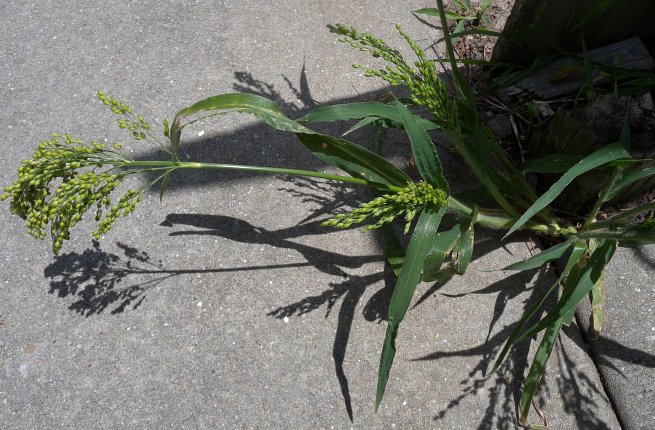
The central axis and branches of each panicle are light to medium green, somewhat wiry, and glabrous or scabrous (rough-textured and clinging). The outer branches terminate in pedicellate spikelets; the spikelets are ovoid in shape and whitish green while they are immature. Each spikelet is 4.5–5 mm. long, consisting of 2 outer glumes, a sterile outer lemma, a fertile inner lemma, and a floret. One glume is 2.5–3 mm. in length, while the other glume is the same length as the spikelet. The outer lemma is also the same length as the spikelet. Both the glumes and lemmas are glabrous and longitudinally veined; the shorter glume has 3-5 dark green veins, while the longer glume and outer lemma have 7-11 dark green veins. The outer sides of both glumes and lemmas are convex. Each floret has an ovary with a pair of feathery stigmas and 3 stamens. The blooming period can occur from early summer into the autumn. However, individual plants remain in bloom for only 1 week; they are cross-pollinated by the wind. Afterwards, the florets are replaced by grains (one grain per spikelet). Mature grains are about 3 mm. long, ovoid or broadly ellipsoid in shape, partially flattened on one side, glabrous, and nearly white to reddish brown. The root system is fibrous. This grass reproduces by reseeding itself.
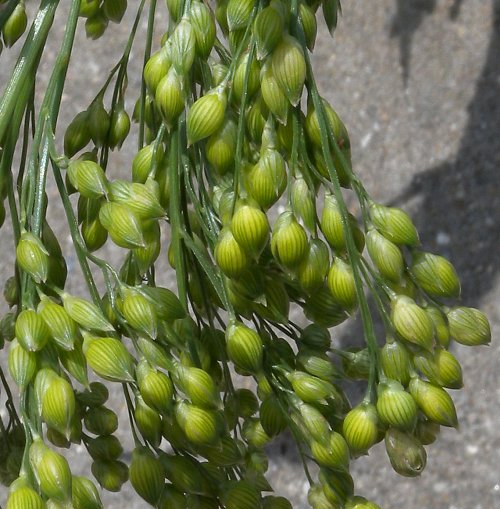
Cultivation: This grass adapts to full sun, moist to dry conditions, and soil containing clay-loam, loam, sandy loam, or gravelly material. Even though it is a warm-season grass with a C4 metabolism, once the seed has germinated, it can develop and mature quickly. The size of individual plants is highly variable, depending on moisture conditions, soil fertility, and the cultivar. Resistance to drought is quite good.
Range & Habitat: The non-native Proso Millet occurs in NE Illinois, east-central Illinois, and scattered areas elsewhere in the state (see Distribution Map), where it is uncommon overall. It was originally introduced into North America from Eurasia as a source of forage; this grass now occurs on several continents. Habitats include cropland, fallow fields, mined land, areas along railroads, roadsides, suburban areas where bird feeders are present, and waste areas. Habitats with a history of disturbance and exposed ground are preferred. Because this grass is sometimes used as a source of birdseed, it can be found in the vicinity of bird feeders as birds occasionally transport the grains to neighboring areas.
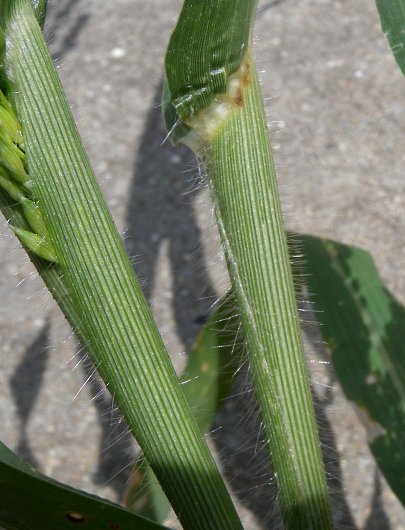
Faunal Associations: The following insects are known to feed on Proso Millet: the Toothed Flea Beetle (Chaetocnema denticulata), Corn Flea Beetle (Chaetocnema pulicaria), Northern Corn Rootworm (Diabrotica barberi), Corn Blotch Leafminer (Agromyza parvicornis), Grass Sheath Miner (Cerodontha dorsalis), Greenbug (Schizaphis graminum), and English Grain Aphid (Sitobion avenae); see Clark et al. (2004), Needham et al. (1928), and Robinson & Bradley (1965). These insects also feed on Corn (Zea mays) and other grasses. Other insects are known to feed on panic grasses (Panicum spp.), although they have not been observed on Proso Millet specifically. This latter group of insects includes a gall fly (Calamomyia panici), a stilt bug (Jalysus spinosus), plant bugs (Collaria meilleuri, Collaria oculata), stink bugs (Euschistus servus, Oebalus pugnax), several species of aphids, larvae of grass leaf-mining moths (Elachista radiantella, Elachista solitaria), and the Sulphur-winged Grasshopper (Arphia sulphurea); see Felt (1917), Froeschner (1942), Wheeler et al. (1983), Rider (2009), Blackman & Eastop (2013), Needham et al. (1928), and Gangwere (1965).
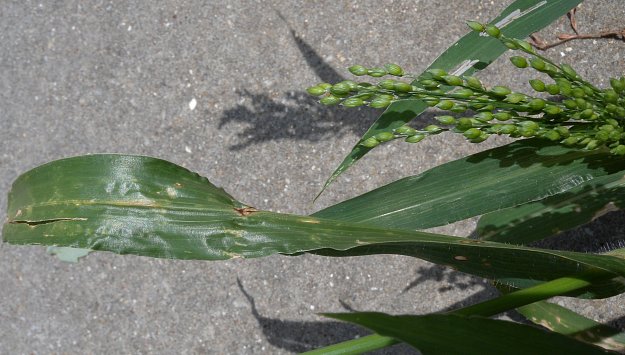
In addition, the larvae of several skippers feed on the foliage of panic grasses: the Indian Skipper (Hesperia sassacus), Hobomok Skipper (Poanes hobomok), Tawny-edged Skipper (Polites themistocles), and Northern Broken-Dash (Wallengrenia egeremet); see Bouseman et al., 2006. The seeds of panic grasses are an important source of food to upland gamebirds and granivorous songbirds, especially various species of sparrows (see Bird Table). The seeds are also eaten by the wild House Mouse and Prairie Deer Mouse (Whitaker, 1966). The young foliage of these grasses is palatable to deer, rabbits, horses, cattle, and sheep.
Photographic Location: Along the edge of a parking lot at the webmaster's apartment complex in Urbana, Illinois.
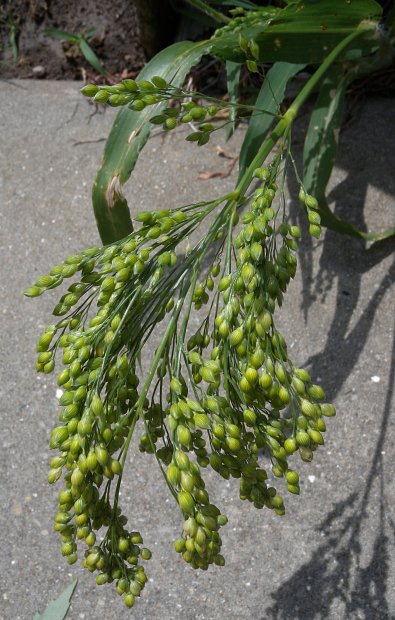
Comments: Proso Millet (Panicum miliaceum) is one of the easier panic grasses (Panicum spp.) to identify because of its large spikelets (4.5–5 mm. in length). These spikelets are always glabrous and the sheaths of this grass always have long spreading hairs. Its leaf blades are also wider than those of most panic grasses. Proso Millet is a member of the Witchgrass group of panic grasses. Grasses in this group are warm-season annuals. Proso Millet may be a polyploid hybrid of Witch Grass (Panicum capillare) and Torpedo Grass (Panicum repens); it was cultivated in temperate areas of China as long as 10,000 years ago (Hunt et al., 2014; Lu et al., 2009). Today, Proso Millet is used in agriculture to only a minor extent, as it has been replaced by more modern grains and there are other grasses that provide better forage to domesticated livestock. Another common name of this grass is Broomcorn Millet.